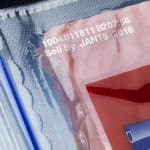 The article by Drew Weightman, Global Business Unit Manager at Videojet Technologies.
The article by Drew Weightman, Global Business Unit Manager at Videojet Technologies.As flexible packaging becomes thinner and thinner to improve sustainability scores, the challenge becomes greater and more difficult to consistently apply legible "date codes". New technologies in materials and machinery have advanced the use of reduced substrates in most flexible packaging applications including form, fill and seal; thermoform and tray sealing; and pouch filling.
Despite material reductions, these formations provide the extended shelf required to protect brand freshness over a set period of time. To make sure brands communicate this "freshness" it's critical to have date codes on every package that consumers and retailers can easily read.
Here are four critical points that can help you efficiently overprint high-resolution codes automatically on today's downgauged flexible packaging:
1. Reduce risk of film perforation and material waste
So here's the top line: use Thermal Transfer Overprinting (TTO), a high-resolution digital printing system, instead of older analog printers such as hot stamps (a.k.a hot foil) or roller printers. Analog printers typically use metal stamps that are held in a heated block. These stamps need to be replaced every time a new job is required in order to change code data. Worn or broken stamps are a common occurrence and lead to poor print quality and perforation of the packaging film - resulting in high levels of waste and rework.
Stamping flexible packaging substrates, particularly downgauged constructions, to apply codes does not provide the user with the optimum coding performance. Digital TTO systems, which are a more forgiving technology, were developed specifically to transfer high-resolution codes directly onto flexible film packaging and labels. TTO uses a precision ceramic printhead, which transfer crisp legible codes from a thermal transfer ribbon directly onto the packaging films. This process transfers codes at 300 dpi (dots per inch/12 dots per mm) onto films just prior to sealing the package. TTO systems can be engineered to mount onto most flexible packaging systems so that codes can be applied efficiently and accurately on to packaging films.
2. Seek real-time coding systems that enhance output
TTO is a digital technology, which means it contains a real-time clock computer chip. It has the ability to print variable information including dates, lot codes, time and even graphics. This advanced technology allows information to be updated automatically so that it's not necessary to stop production lines when new codes are required. Real-time coding supports prudent traceability.
This differs significantly from analog printers, which use fixed metal stamps that need to be replaced every time a new package requires an updated code. Also since stamps are fixed - variable information such as real-time codes from one package to the next is not possible.
3. Select the right ribbon for each application
To gain excellent TTO code resolution for each package it's important to work with a coding partner that will assess your application needs and provide the appropriate ribbon type. Just like applications differ, so do ribbons. For instance, for fresh-made soups and other hot-fill applications (180-195oF) choose a special extreme temperature ribbon that will generate crisp, clean codes. Also depending upon line speeds, film or label type, or chemical resistance requirements, the right ribbon should be used to achieve maximum coding results and output. In addition, selecting the proper ribbon will enhance the life and performance of the system's printhead.
When it is time to replace the used ribbon, the TTO ribbons changeovers are fast due to simple cassette design.


